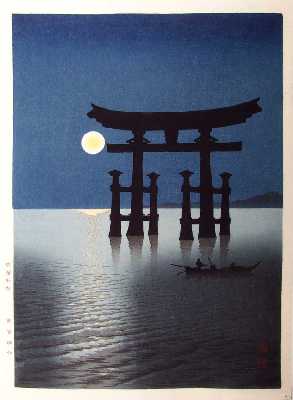To collectors of Japanese woodblock prints, certainly the various 21 "Night Scene" images produced by
Hasegawa/Nishinomiya Publisher are delightful prints to both view and to collect. Their images are truly evocative
of the early 1900's period in Japan with which collectors of Japanese prints were so enamored--a style of
prints which came to be known of collectively as "shin-hanga."
Literature (and print) sources used in preparation of this and other articles include:
Contributor: Marc Kahn (comments and observations)
Above documented prints courtesy of: Ukiyoe-Gallery and Marc Kahn (of Shotei.com website)
"Takejiro Hasegawa: Meiji Japan's Preeminent Publisher of Wood-Block-Illustrated Crepe-Paper Books,"
by Frederic A. Sharf, (page 13: "Takejiro Hasegawa died in Tokyo on 19 July 1938, by which time Yosaku was
running the business, publishing under the Nishinomiya name.")
"Guide to Modern Japanese Woodblock Prints: 1900-1975", by Helen Merritt and Nanako Yamada, University of Hawaii Press, Honolulu, ISBN 0-8248-1732-X
"Kawase Hasui -- The Complete Woodblock Prints", by Kendall H. Brown & Shoichiro Watanabe, Hotei (KIT) Publishing, Netherlands, ISBN 90-74822-46-0
"Crows, Cranes and Camellias: The Natural World of Ohara Koson", by Amy Reigle Newland, Jan Perree, Robert Schaap, Hotei (KIT) Publishing, Netherlands, ISBN 90-74822-38-X

